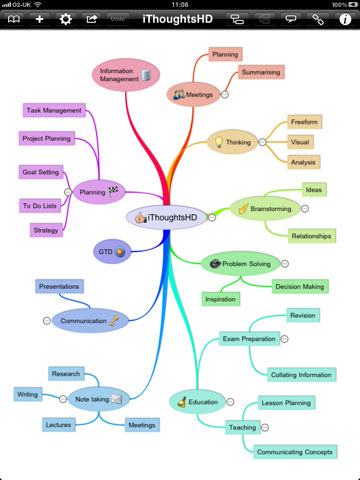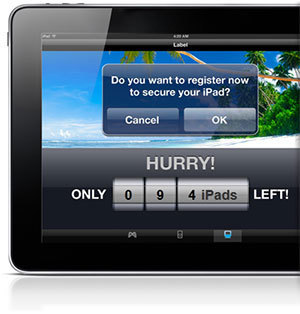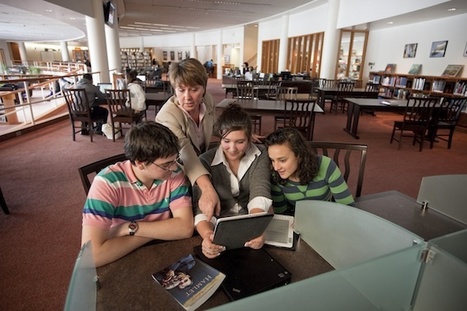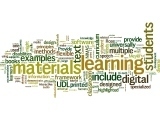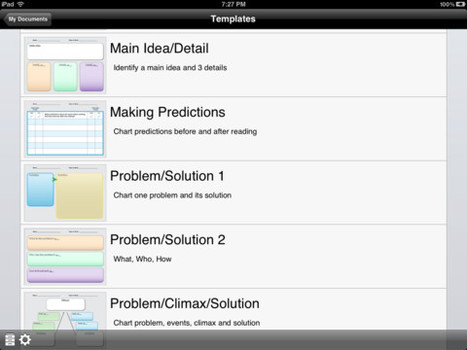 Your new post is loading...
 Your new post is loading...

|
Scooped by
Kathleen McClaskey
November 11, 2011 12:14 PM
|
"UDL is an outgrowth of UD, and utilizes the mindset that everyone has individual learning needs and preferences. By acknowledging this diversity, UDL helps us to create flexible learning environments and curriculum that cater to these needs, thereby increasing accessibility for all students. Instead of making adaptations on a person-by-person basis, UDL embeds choice and flexibility into the design of lesson plans and learning environments, ultimately making them available to everyone from the get-go."
From inov8 Educational Consulting
Welcome to Part 5 of There's A Special App For That series on iPhone, iPod Touch and iPad apps for students with special needs. In this post we round up 5 great mind mapping apps for children with learning disabilities who are visual learners.
Our criteria for mind mapping apps: Apps for mind mapping are generally developed for a mass market and not specifically for educational use or for students with special needs. With so many apps on the market, we developed some basic criteria that we used to target the needs of a student with learning disabilities: - Simple to use for middle and high school students
- Uncluttered interface
- Ability to manipulate “nodes” or ideas on the screen easily for those with fine motor difficulties
- Ability to use graphics instead of text, if needed
- Multiple options to use varying colors and shapes to differentiate ideas and to provide increased meaning and structure for the student.
- Ability to export the map into different formats, so that the student can manipulate the map afterwards for the writing process.
For the college level student, determining how you learn best and using materials that cater to your style can be a great way to make school and the entire process of acquiring new information easier and much more intuitive. Although this site does not make specific reference to UDL, it does include websites that are categorized for three learning styles that could be used to support the principles of UDL: Visual, Auditory and Kinesthetic.
Via Naomi Harm, Barbara Bray

|
Rescooped by
Kathleen McClaskey
from UDL & ICT in education
November 3, 2011 3:14 PM
|
Pacecar is an online reading tool, designed to help you read faster and with more focus. It masks the distracting elements on the page, giving you a reading window that follows your mouse.
Via Smaragda Papadopoulou
From Spectronics in Australia, Greg O'Connor has compiled a comprehensive list of apps for reading, writing, etc. along with a description, video and comments on each app. Share this far and wide.

|
Scooped by
Kathleen McClaskey
November 2, 2011 4:49 PM
|
"The partners will leverage existing, high-quality literacy curricula and content-area instructional strategies to develop this approach, guided by the principles of universal design for learning (UDL), a research-based framework for designing effective and fully inclusive learning environments."

|
Scooped by
Kathleen McClaskey
October 29, 2011 5:59 PM
|
"Anita Strang is a Vice Principal of an Elementary School who is passionate about designing learning environments that are personalized with the goal of supporting children in becoming successful learners who are able to find joy and passion in learning and in being present in their lives and their communities. I believe that as we rethink schools we need to widen our vision and see schools as community hubs where we come together to raise our children." She shares her blog that contains a wealth of resources for any educator who wants to create a UDL environment.

|
Scooped by
Kathleen McClaskey
October 28, 2011 6:05 PM
|
See the Glog! Learning about UDL: accommodations, cast, differentiation, inclusion, udl | Glogster EDU - 21st century multimedia tool for educators, teachers and students...
The Inclusive Learning Technologies Conference 2012 Committee has just achieved one of the major conference milestones; the final program has been announced!

|
Scooped by
Kathleen McClaskey
October 24, 2011 10:31 PM
|
Please join in the conversation w/ @irasocol about UDL, October 26 @ 11:30 a.m.

|
Scooped by
Kathleen McClaskey
October 24, 2011 2:06 PM
|
A private high school in Massachusetts has replaced its traditional library with a collaborative, all-digital facility. Does an all-digital library support the principles of UDL? Although they are offering an all-digital library that can be read by any number of readers, it has eliminated the hard copy. The hard copy is preferred by some students. In this case, throwing out the old for the new does not always fair well when you are trying to support all the learners in the school.

|
Scooped by
Kathleen McClaskey
October 21, 2011 11:05 AM
|
The University of Louisville UDL site includes an excellent Beginners' Guide to Implementing Universally Designed Classroom Content by Michael Abell.

|
Scooped by
Kathleen McClaskey
October 18, 2011 5:29 PM
|
This wiki provides a comprehensive set of UDL resources including Web 2.0 tools, wikis, blogs, podcast, strategies, videos and more that you will surely bookmark for future reference. Share this far and wide.
|

|
Rescooped by
Kathleen McClaskey
from UDL & ICT in education
November 9, 2011 6:15 PM
|
The Center on Disability Studies (CDS) staff are committed to facilitating success for all participants in Universities and colleges, including faculty, administrators, staff, and students. The "Teaching All Students, Reaching All Learners" project, funded by the US Department of Education, Office of Postsecondary Education, will share teaching techniques CDS has researched, developed, and synthesized that will enhance the quality of work for both faculty and students, as both populations advance in the university and college setting.
Via Smaragda Papadopoulou

|
Scooped by
Kathleen McClaskey
November 6, 2011 5:52 PM
|
"A service called Bookshare makes traditional books quickly accessible for students with certain disabilities."
Access to the curriculum and reading materials for students with print and visual disabilities is a key step for schools to achieve acaemic success for all students. Bookshare is the respository for K-12 copyrighted and non-copyrighted books and textbooks for students with print and visual disabilities. This service is currently at no cost to schools in the United States. They also offer a select number of free reading tools and there is an app designed to work with Bookshare books. Learn more at bookshare.org.

|
Scooped by
Kathleen McClaskey
November 6, 2011 4:04 PM
|
"This site serves as a resource to state- and district-level educators, parents, publishers, conversion houses, accessible media producers, and others interested in learning more about and implementing AIM and NIMAS."
- LEARN about Accessible Media, Policy and Practice
- EXPERIENCE AIM and NIMAS Tools and Resources
- COLLABORATE with the AIM Community

|
Scooped by
Kathleen McClaskey
November 3, 2011 3:09 PM
|
Excellent Blog articles on Universal Access and UDL from Australia.
"25 graphic organizers for students to use to organize their thinking while reading preparing to write. Covers all common comprehension skills: cause /effect, main idea/detail, sequence events, pro/con, story elements, characterization, word meaning, plot, KWL and much more."
Via Stephanie Sandifer, Kathleen McClaskey

|
Scooped by
Kathleen McClaskey
November 2, 2011 3:05 PM
|
Massachusetts moving forward on Universal Design and Assistive Technology.

|
Scooped by
Kathleen McClaskey
October 29, 2011 10:00 AM
|
AASL11 Learning Commons presentation on Universal Design for Learning and creating access for all learners in the library.

|
Rescooped by
Kathleen McClaskey
from UDL & ICT in education
October 26, 2011 9:29 AM
|
schoolX has introduced a course on accessibility for teachers that are creating online courses. It is part of a teaching professional’s skills to understand the needs of a diverse population of students. This unit introduces the challenges for disabled students who may use computers in different ways when taking part in eLearning or may need alternative teaching methods. It covers the technology and techniques used by disabled students, the adjustments to teaching methods that might be reasonable, design decisions which affect the accessibility of eLearning tools and strategies for evaluation.
Via Smaragda Papadopoulou

|
Scooped by
Kathleen McClaskey
October 25, 2011 8:38 PM
|
Guest post by Peter H. Reynolds. Celebrating Educators Who Understand We Need More Creative Ways to Reach ALL Learners..
The Reynolds Center serves as a retreat & recharge center where we invite creative educators to come join us – to be inspired, to learn new ways to reach ALL learners and to help us research & develop innovative learner-centric tools and resources to use in the classroom – and all the places we learn (library, community center, home, museum, etc.)

|
Scooped by
Kathleen McClaskey
October 24, 2011 3:29 PM
|
Learning Score is an amazing multimedia lesson-planning and delivery tool that uses a music score metaphor to show the range of planned activities for a lesson as a graphical time line.
"Learning Score was invented by John Davitt and grew out of a desire to provide teachers and learners with a modern, flexible, technology-friendly and pedagogically rigorous approach to lesson-planning that is suitable for the 21st-century classroom." Why UDL? Lessons can be created and organized using digital files, audio, video, animation and photos that would support the UDL principle, Multiple Means of Representation. Lessons can be published online or in print for students to use.
"Is there is a way to narrow the middle school science and math gap for children with disabilities? According to one researcher, Dr. Matthew Marino of Washington State University, perhaps it has already arrived, via a STEM (Science, Technology, Engineering and Math) curriculum in a Universal Design for Learning (UDL) framework underpinned by nascent assistive and instructional technology. " A "must read" on UDL and STEM published by The Family Center on Technology and Disability.

|
Scooped by
Kathleen McClaskey
October 18, 2011 6:04 PM
|
Universal Design for Learning: Reaching All Learners at the Harvard Graduate School of Education Programs in Professional Education - July 9-13, 2012. "The UDL approach considers the needs of the greatest number and range of possible learners and offers educational methods to eliminate the need for costly, cumbersome and after-the-fact adaptations. It requires the collaboration of experts in teaching, educational administration, policymaking, technology and publishing and provides a blueprint for creating flexible goals, methods, materials and assessments that enable all students to succeed in the classroom."
|
 Your new post is loading...
Your new post is loading...
 Your new post is loading...
Your new post is loading...








